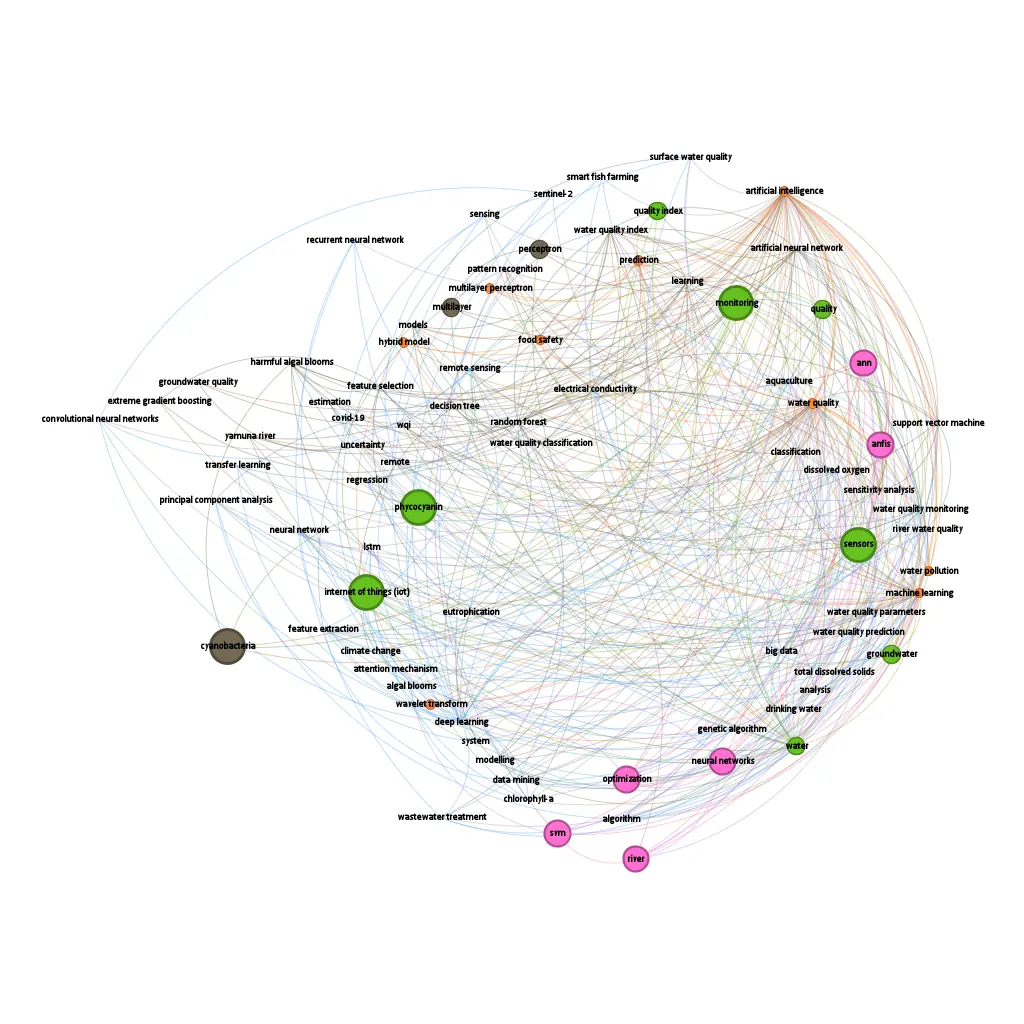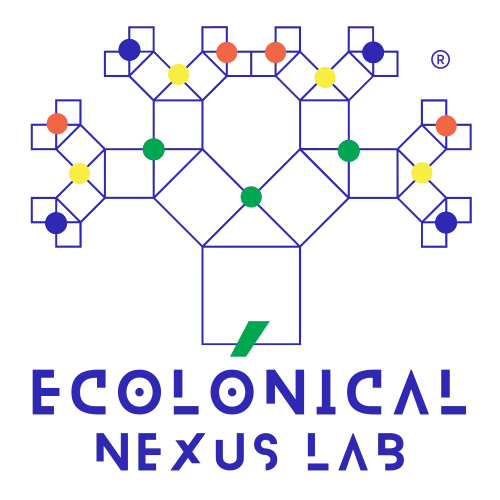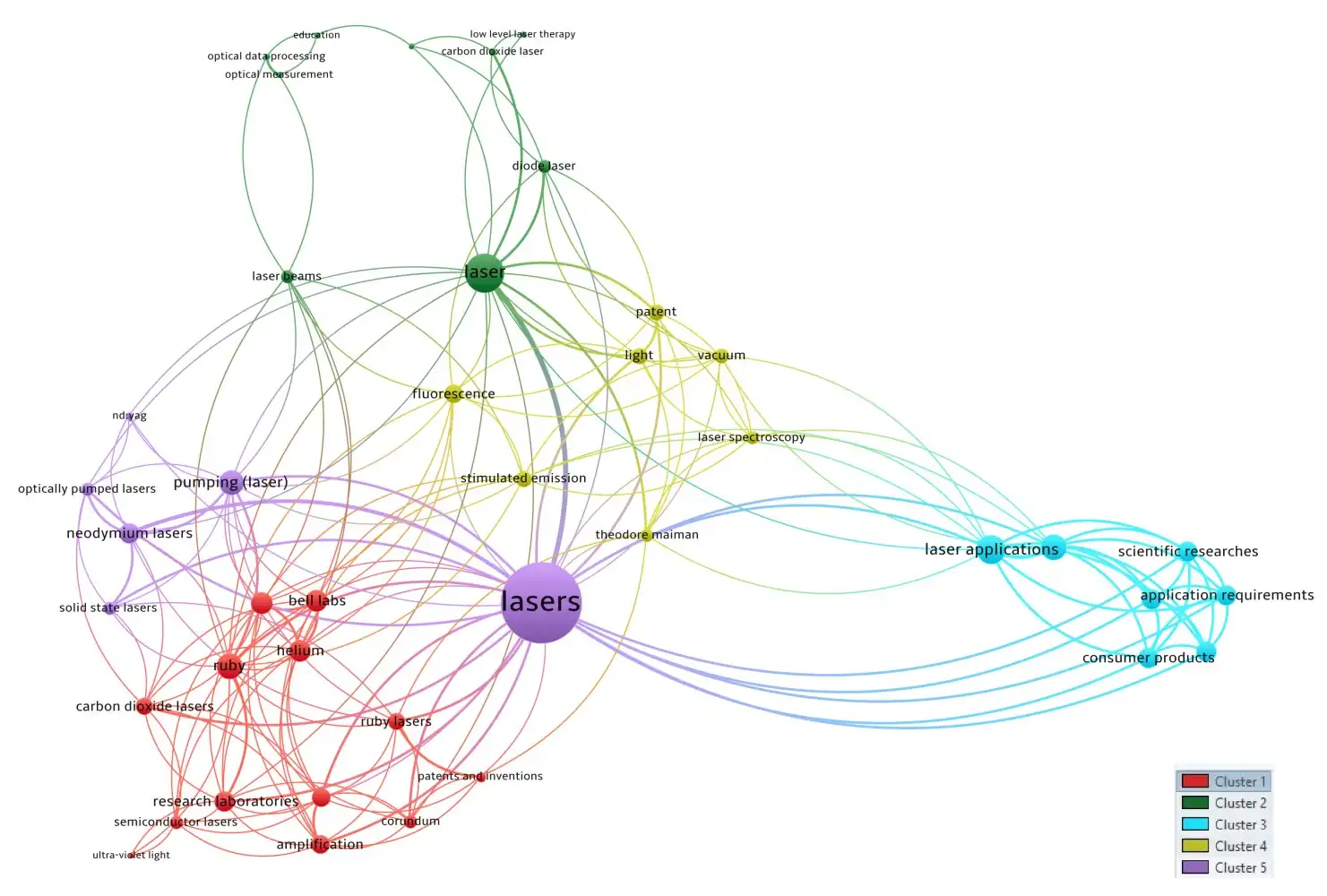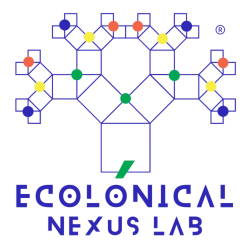V. RESULTS
The network analysis of the corpus revealed the presence of five distinct communities (0-4) within the water quality research domain topics:
- Algal Blooms, Algorithm, Analysis, Aquaculture, Artificial Neural Network, Attention Mechanism, Big Data, Chlorophyll-a, Classification, Climate Change, Convolutional Neural Networks, COVID-19, Data Mining, Decision Tree, Deep Learning, Dissolved Oxygen, Drinking Water, Electrical Conductivity, Estimation, Eutrophication, Extreme Gradient Boosting, Feature Extraction, Feature Selection, Genetic Algorithm, Groundwater Quality, Harmful Algal Blooms, Learning, LSTM, Modelling, Models, Neural Network, Pattern Recognition, Principal Component Analysis, Random Forest, Recurrent Neural Network, Regression, Remote Sensing, River Water Quality, Sensing, Sensitivity Analysis, Sentinel-2, Smart Fish Farming, Support Vector Machine, Surface Water Quality, System, Total Dissolved Solids, Transfer Learning, Uncertainty, Wastewater Treatment, Water Quality Classification, Water Quality Index, Water Quality Monitoring, Water Quality Parameters, Water Quality Prediction, WQI, Yamuna River.
This community encompasses a diverse set of topics and research areas related to water quality, artificial intelligence, data science, and statistics. It includes a range of applications addressing challenges such as algal blooms, aquaculture management, climate change impacts, and water quality monitoring, utilizing various methods, algorithms, key performance indicators (KPIs), and indicators to investigate and address these issues.
Use Case: Algal Bloom Prediction and Management
One potential use case within this community is the prediction and management of algal blooms. Researchers employ artificial neural networks, convolutional neural networks, and recurrent neural networks to develop models that incorporate factors such as chlorophyll-a concentrations, water quality parameters, and satellite imagery. The use of AI and data-driven approaches enables proactive monitoring and management of algal blooms.
Method and Algorithms: Employing Advanced Predictive Techniques
To address the complex relationships between water quality parameters and algal blooms, researchers utilize deep learning techniques like LSTM networks, CNNs, and RNNs. These methods are adept at analyzing time-series data, satellite imagery, and multi-dimensional datasets. Other algorithms such as decision trees, random forests, SVMs, and XGBoost are applied for classification, prediction, and feature selection tasks, aiding in the identification of relevant indicators and features for water quality analysis and forecasting.
KPIs and Indicators: Metrics for Quality Assessment
KPIs such as Water Quality Index (WQI), Total Dissolved Solids (TDS), chlorophyll-a concentrations, and dissolved oxygen levels are crucial in this community’s work. These indicators provide quantitative measures of water quality parameters and algal bloom characteristics, contributing to the development of robust models and informed water quality management strategies.
- Artificial Intelligence, Food Safety, Hybrid Model, Machine Learning, Multilayer Perceptron, Prediction, Water Pollution, Water Quality, Wavelet Transform.
Community 1 focuses on employing artificial intelligence (AI), data science, and machine learning techniques to address water quality and food safety concerns. Researchers explore the use of hybrid models, integrating machine learning algorithms like multilayer perceptron (MLP) and wavelet transform, to predict and mitigate water pollution and ensure stringent water quality standards for safe food production.
Use Case: AI-Driven Pollution Monitoring for Food Safety
One prominent use case within this community is the prediction and assessment of water pollution to ensure food safety. By leveraging artificial intelligence and machine learning, researchers can develop hybrid models that integrate data from various sources such as water quality parameters, environmental factors, and food safety indicators. These models aim to predict and identify potential sources of water pollution that may affect the safety and quality of food produced from aquatic environments. The application of AI and data-driven approaches enables proactive monitoring and risk assessment, contributing to improved food safety practices.
Method and Algorithms: Hybrid Modeling Techniques
Researchers in this community utilize hybrid models that combine machine learning algorithms and techniques such as multilayer perceptron (MLP) and wavelet transform. The multilayer perceptron is a type of artificial neural network characterized by multiple layers of interconnected nodes or neurons. MLPs excel in capturing complex relationships and patterns within data, making them suitable for analyzing water quality and pollution-related datasets. The wavelet transform, on the other hand, is a mathematical technique that decomposes signals into different frequency components, enabling the identification of hidden patterns and anomalies in water quality data. By combining these methods, researchers can leverage the strengths of each approach and enhance the accuracy and interpretability of their models.
KPIs and Indicators: Water Quality and Food Safety Metrics
KPIs can include metrics such as water quality indices, pollutant concentrations (e.g., nutrient levels, heavy metals), and food safety indicators (e.g., microbial contamination). These indicators provide quantitative measures of water quality and food safety parameters, enabling the assessment of potential risks and the identification of mitigation strategies. Additionally, the use of wavelet transform allows researchers to analyze the time-frequency characteristics of water quality data, enabling the detection of temporal variations and irregularities that may impact food safety.
- Groundwater, Multilayer Perceptron, Quality, Quality Index, Water.
Community 2 focuses on the study of groundwater quality assessment using the multilayer perceptron (MLP) neural network and quality indices. This community aims to understand and evaluate the quality of groundwater resources, which are crucial for various purposes such as drinking water supply, irrigation, and industrial use.
Use Case: Comprehensive Groundwater Quality Modeling
The primary use case within this community is the assessment of groundwater quality. Groundwater serves as a vital source of freshwater, and its quality directly impacts human health and the environment. Researchers within this community employ data science and artificial intelligence techniques, particularly the multilayer perceptron neural network, to model and predict groundwater quality based on various parameters and indicators.
Method and Algorithms: Neural Network Proficiency
The multilayer perceptron (MLP) neural network is a popular algorithm used in this community to assess groundwater quality. The MLP is a feedforward neural network with multiple layers of interconnected artificial neurons that can capture complex relationships between input variables and groundwater quality indicators. Researchers input data related to groundwater characteristics such as pH, electrical conductivity, dissolved oxygen, nitrate levels, heavy metal concentrations, and other relevant parameters into the MLP model. By training the model on historical data, it can learn the underlying patterns and relationships between these parameters and groundwater quality. The MLP model then provides predictions or classifications of water quality based on the input variables.
KPIs and Indicators: Groundwater Quality Metrics
Quality indices, such as the Water Quality Index (WQI), are composite metrics that combine multiple water quality parameters into a single value or score. These indices provide a standardized measure of groundwater quality, allowing for easy comparison and interpretation. Additionally, specific indicators, such as pH, electrical conductivity, and concentrations of contaminants, serve as key metrics to assess different aspects of groundwater quality. By analyzing these indicators and employing quality indices, researchers can evaluate the overall health and suitability of groundwater for various uses.
- ANFIS, ANN, Neural Networks, Optimization, River, SVM.
Community 3 focuses on the application of adaptive neuro-fuzzy inference systems (ANFIS), artificial neural networks (ANN), and support vector machines (SVM) in the context of river water quality analysis and optimization. This community aims to develop and utilize advanced computational techniques to understand, model, and optimize water quality in rivers.
Use Case: Enhanced River Ecosystem Management
The primary use case within this community is the analysis and optimization of river water quality. Rivers play a crucial role in providing freshwater resources for various human activities, including drinking water supply, irrigation, and recreation. Understanding the factors influencing river water quality and developing models to predict and optimize it are essential for maintaining a sustainable water ecosystem.
Method and Algorithms: Computational Intelligence for Rivers
Researchers within this community employ a range of methods and algorithms, including ANFIS, ANN, neural networks, optimization techniques, and SVM, to analyze and model river water quality. ANFIS is a hybrid computational model that combines fuzzy logic and neural network approaches to capture the complex relationships between input variables and water quality indicators. ANN, on the other hand, is a computational model inspired by the biological neural network, capable of learning and adapting to patterns in the data. These models are trained using historical data on river water quality, including parameters such as pH, dissolved oxygen, turbidity, nutrient concentrations, and other relevant factors. By optimizing the model’s parameters and structure using optimization algorithms, researchers can improve the accuracy and predictive capabilities of the models. SVM is another machine learning algorithm utilized within this community, known for its ability to perform well on classification and regression tasks, including water quality prediction.
KPIs and Indicators: River Health Metrics
KPIs may include metrics such as prediction accuracy, precision, recall, or the mean squared error of the models. These metrics help evaluate the performance of ANFIS, ANN, and SVM models in capturing and predicting water quality patterns. Additionally, specific water quality indicators, such as nutrient concentrations, chemical oxygen demand (COD), biological oxygen demand (BOD), and turbidity, serve as key measures of river water quality. By analyzing these indicators and employing computational models, researchers can gain insights into the current state of the river ecosystem and identify potential optimization strategies.
- Cyanobacteria, Internet of Things (IoT), Monitoring, Phycocyanin, Sensors.
Community 4, as identified through network analysis, focuses on the utilization of the Internet of Things (IoT) and sensor technologies for the targeted monitoring and management of cyanobacteria, known for causing harmful algal blooms (HABs) in aquatic environments. The emergent themes within this community reflect a significant trend towards technological integration in water quality research, particularly the detection and analysis of cyanobacteria-related parameters.
Emergent Themes: Real-Time Cyanobacteria Detection and Monitoring
The analysis identified a concentrated focus on employing IoT and sensor technologies to develop real-time, efficient monitoring systems. These systems are designed to detect the proliferation of cyanobacteria swiftly, facilitating early warning and timely mitigation strategies against the detrimental effects of HABs.
Methodological Advancements: IoT and Sensor Deployment
Within this community, the methodological advancement lies in the strategic deployment of IoT-enabled sensors across water bodies. These sensors are capable of continuously collecting and transmitting water quality data, including key parameters indicative of cyanobacterial activity such as phycocyanin levels. The network analysis highlights the prevalent use of temperature, pH, and dissolved oxygen sensors, amongst others, to provide a comprehensive real-time view of the water’s condition.
Technological Integration: Data Analysis and Machine Learning
The community’s results also emphasize the integration of data analysis techniques and machine learning algorithms to interpret the sensor data effectively. This includes employing statistical analysis, time series analysis, and various classification algorithms to identify patterns, predict potential HAB occurrences, and understand the environmental conditions conducive to cyanobacteria proliferation.
Impact and Indicators: Monitoring System Efficacy and Water Quality
The community’s research has led to identifying key performance indicators (KPIs) critical for evaluating the effectiveness of the monitoring systems. These include the accuracy of sensor measurements, the responsiveness of the monitoring system, and the reliability of early warning systems. Water quality indicators like phycocyanin concentration, chlorophyll-a levels, and dissolved oxygen levels are also integral in assessing the presence and impact of cyanobacteria and HABs.
Overall, Community 4 illustrates a distinct segment of the network focused on advancing IoT and sensor-based technologies for the proactive and precise monitoring of cyanobacteria. The integration of real-time data collection, advanced analytics, and machine learning represents a forward leap in water quality management, offering insights into the dynamics of aquatic ecosystems and enhancing the ability to respond to environmental challenges effectively.










Leave a Reply